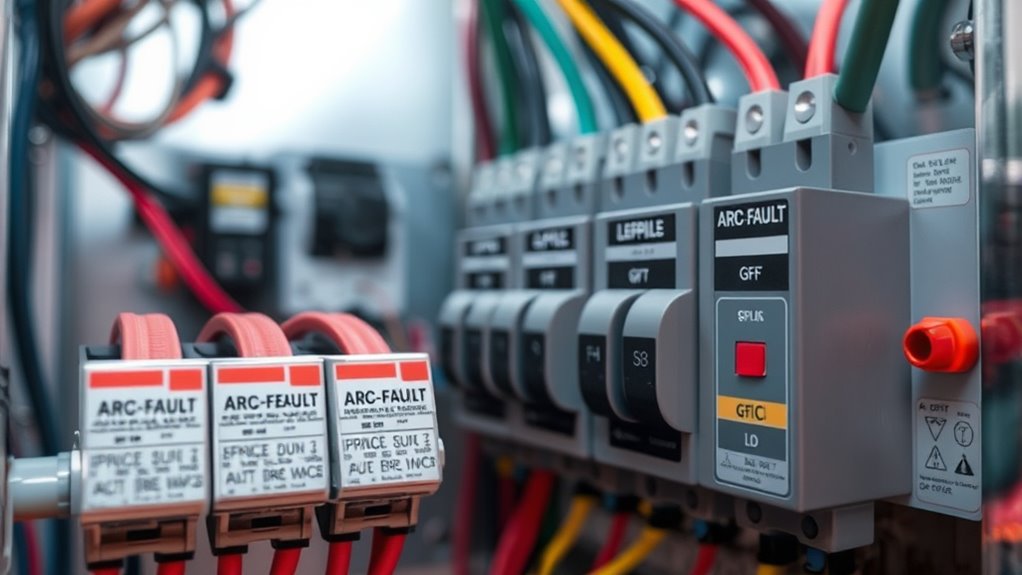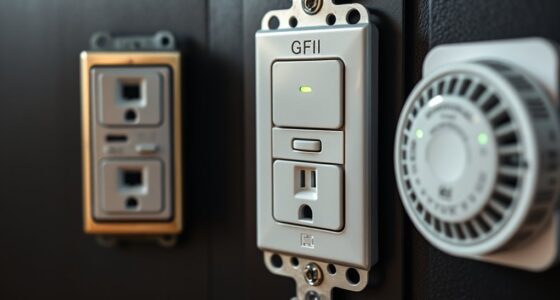When combining AFCIs and GFCIs, bust common myths by understanding they serve different safety roles—AFCIs prevent fires from arc faults, while GFCIs stop ground-fault shocks. Installing both isn’t always straightforward; they can interfere and cause nuisance trips if not properly coordinated. Remember, GFCIs don’t detect arc faults, and AFCIs don’t prevent ground shocks. Ensuring correct setup and understanding their functions is key—finding out more will help you keep your home safe and compliant.
Key Takeaways
- Combining AFCIs and GFCIs doesn’t automatically ensure safety; proper coordination and compatibility are essential.
- Installing both devices on the same circuit may cause nuisance tripping if not correctly configured.
- GFCIs detect ground faults, but they do not reliably identify arc faults; AFCIs are needed for arc fault protection.
- Regular testing of both AFCIs and GFCIs is crucial to maintain their effectiveness and prevent false trips.
- Following electrical codes and consulting qualified electricians ensure proper installation and avoid myths about device interactions.
Understanding the Basic Differences Between AFCIs and GFCIs
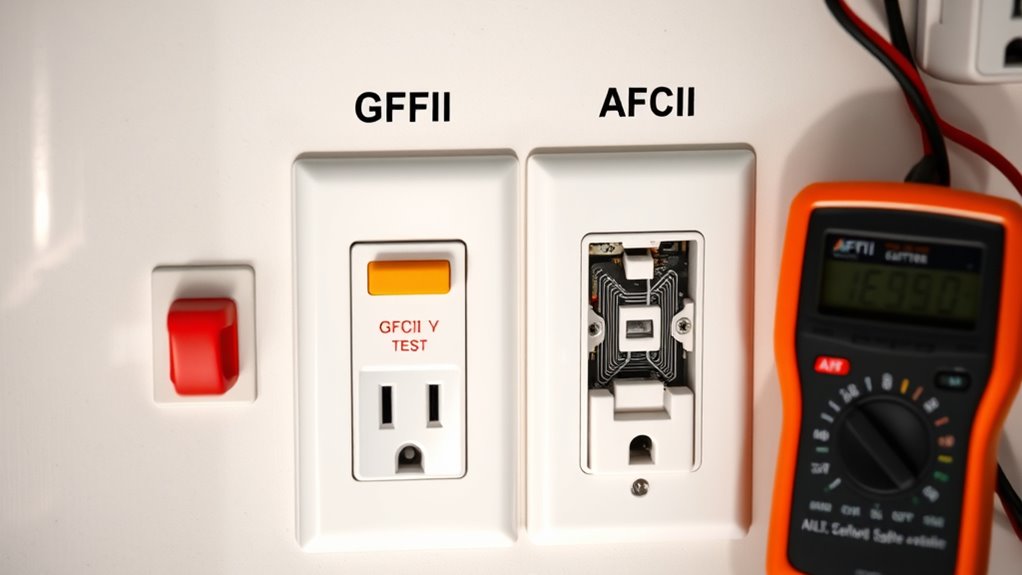
Have you ever wondered how AFCIs and GFCIs differ in protecting your home? The main circuit breaker differences lie in what they detect and prevent. AFCIs are designed to sense arc faults—small sparks caused by damaged wiring or loose connections—that could lead to fires. GFCIs, on the other hand, focus on outlet safety features by detecting ground faults, which occur when current leaks to the ground, risking electric shock. These devices serve different roles but are both essential. AFCIs help prevent electrical fires by shutting off power when dangerous arcing happens. GFCIs protect people from electrocution by quickly cutting power if they detect imbalance in current flow. Understanding these distinctions helps you choose the right safety devices for your home’s electrical system. Security features of home electrical safety devices contribute to overall home safety and peace of mind.
Common Myths About Circuit Interactions and Safety Devices

Many homeowners believe that installing AFCIs and GFCIs together will automatically provide thorough electrical safety, but this is a common misconception. Some think this combination makes circuit breaker myths irrelevant or that fuse misconceptions no longer matter. In reality, safety devices work best when properly selected and maintained, not just installed together. Relying on these devices alone can lead to a false sense of security, ignoring the importance of regular inspections and correct wiring practices. It’s a myth that AFCIs and GFCIs eliminate all electrical hazards or replace traditional circuit breakers and fuses. Understanding these devices’ specific functions and limitations helps you avoid misconceptions, ensuring safety without overestimating their protective capabilities. Proper knowledge is key to effective electrical safety, as comprehensive maintenance and correct installation practices significantly enhance their effectiveness.
How AFCIs Detect and Interrupt Arc Faults
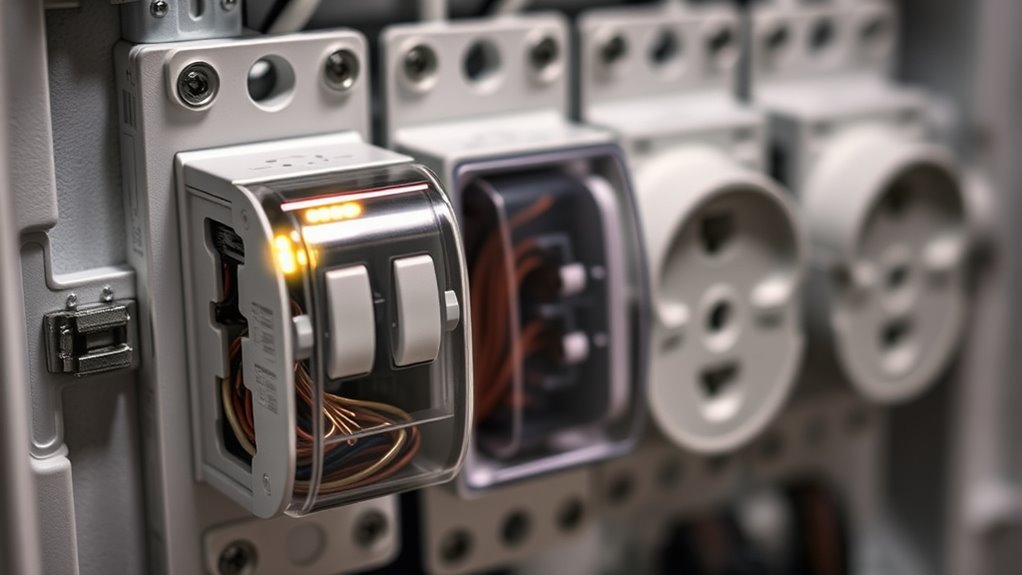
Arc-Fault Circuit Interrupters (AFCIs) are designed to detect the specific electrical signature of an arc fault and interrupt power before it can cause a fire. They monitor the electrical current for irregular patterns typical of arcing, such as intermittent or fluctuating signals. When arc fault detection identifies these patterns, the AFCI quickly trips, cutting off power to prevent ignition of surrounding materials. Unlike GFCIs, which mainly protect against ground faults and shocks, AFCIs focus on identifying dangerous arcing conditions. This targeted detection helps prevent fires caused by damaged wiring or loose connections. By rapidly interrupting arcing, AFCIs address a critical safety gap, though they don’t replace GFCIs, which have their own specific limitations. Both devices work together to improve electrical safety. Understanding how AFCIs detect arcing is essential for comprehensive home electrical safety.
The Role of GFCIs in Preventing Ground Fault Shocks
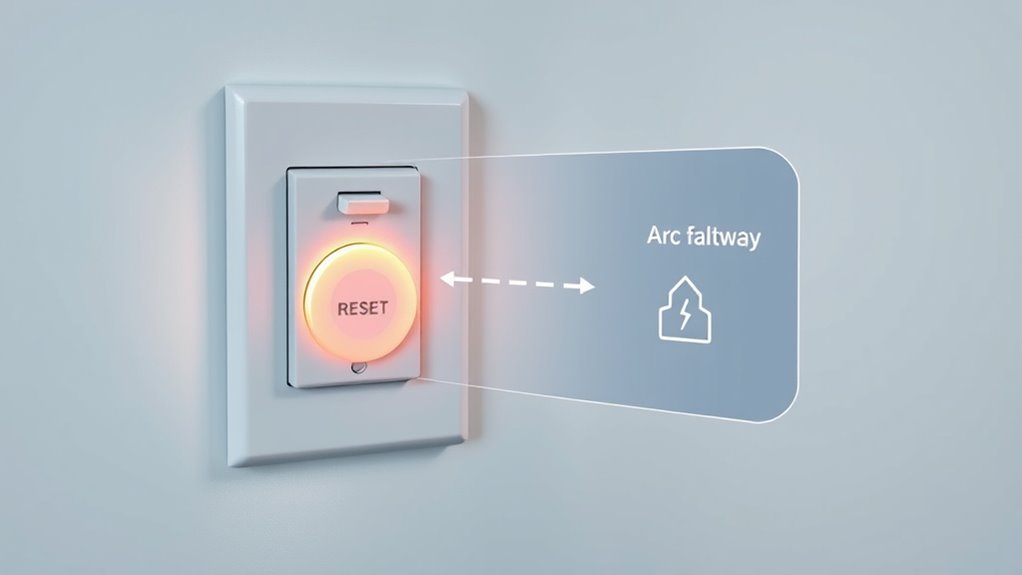
GFCIs play a vital role in detecting ground leaks that could lead to electric shocks. When they sense a difference in current between the hot and neutral wires, they trip instantly to prevent injury. By doing so, GFCIs help keep you safe from potentially dangerous ground fault shocks.
Detects Ground Leaks
Ground leaks can pose serious safety risks, but GFCIs are designed to detect these faults quickly. When a ground leak occurs, current escapes from the intended circuit, creating a ground leak that GFCIs can identify through ground leak detection. During electrical safety testing, GFCIs monitor the balance of current between the hot and neutral wires. If any imbalance is detected, it indicates a ground leak, and the GFCI trips, disconnecting the power. This rapid response prevents electrical shocks and reduces fire hazards caused by ground faults. By continuously monitoring for ground leaks, GFCIs provide an essential layer of safety, helping you identify and address potential issues before they lead to serious accidents or damage.
Prevents Electric Shocks
When a ground leak occurs, current can escape from the circuit and pass through your body, leading to electric shocks. GFCIs are designed to prevent this by quickly detecting imbalances in current flow, unlike traditional circuit breaker myths that assume they protect against shocks. Many electrical safety misconceptions suggest circuit breakers will stop shocks, but they only trip during overloads or short circuits. GFCIs, however, monitor the current difference between the hot and neutral wires and trip instantly if they detect a ground fault. This rapid response considerably reduces the risk of severe shocks. By installing GFCIs in areas prone to moisture, you add an essential layer of protection, ensuring you’re safer from ground fault shocks where traditional circuit breakers fall short. Understanding how ground faults and GFCIs work is crucial for electrical safety and preventing injuries in your home.
Can a GFCI Protect Against Arc Faults?
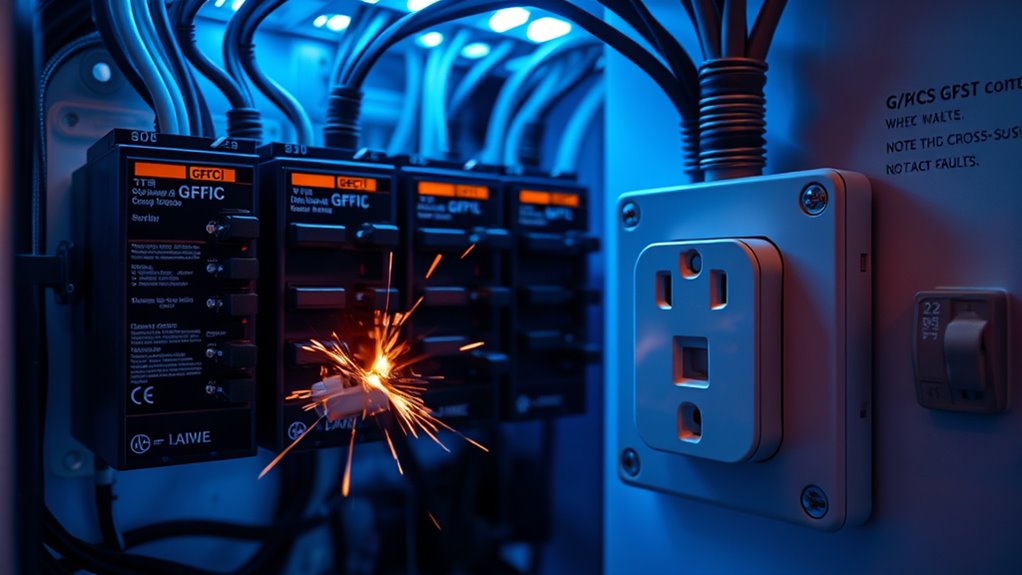
GFCIs are designed to detect ground faults, but they aren’t always capable of stopping arc faults. Their functionality has limits, especially with certain types of arcing that occur quickly or subtly. Understanding what GFCIs can and can’t do helps you better protect your home from electrical fires and shocks. For example, arc fault detection is limited in some GFCI models, which means additional protective devices may be necessary.
GFCI Functionality Limits
Although GFCIs are highly effective at preventing electric shocks caused by ground faults, they have limitations when it comes to arc faults. GFCIs are designed to detect ground faults by monitoring current differences, not the specific circuit breaker design needed to identify arc faults. Because of this, they don’t reliably trip during arc faults, which often produce high-energy, intermittent sparks that bypass GFCI detection. Wiring compatibility also plays a role; improper or outdated wiring can reduce GFCI effectiveness, preventing it from sensing faults properly. While GFCIs protect against ground faults, their ability to detect and protect against arc faults is limited. For extensive safety, consider installing specialized arc-fault circuit interrupters (AFCIs) alongside GFCIs where needed. Additionally, understanding Bedroom wiring and how circuits are configured can help identify potential issues that hinder GFCI performance.
Detecting Arc Faults
GFCIs are primarily designed to detect ground faults by monitoring current differences, but they are not equipped to reliably identify arc faults. This means depending solely on a GFCI won’t improve wiring safety from arc faults. Common circuit breaker myths suggest all devices protect against arcs, but dedicated arc-fault circuit interrupters (AFCIs) are needed for that. To ensure proper protection, consider these points:
- AFCIs detect the unique electrical signature of arcing.
- Standard circuit breakers don’t reliably prevent wiring fires caused by arcs.
- Proper wiring safety includes using AFCIs where required.
- Relying on GFCIs alone leaves gaps in arc fault detection.
Understanding these distinctions helps you avoid circuit breaker myths and enhance overall wiring safety.
The Impact of Installing Both Devices in the Same Circuit
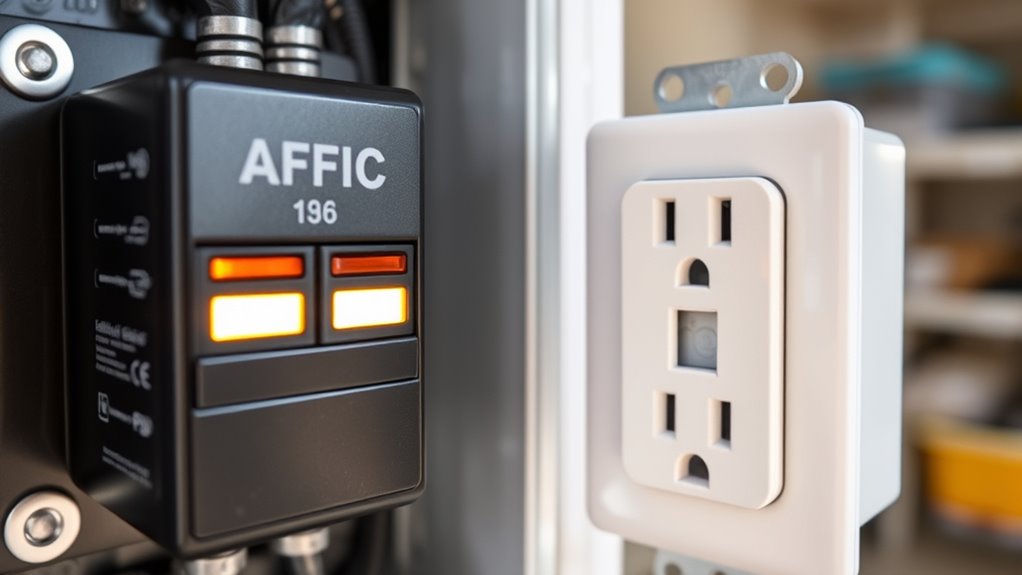
Installing both arc-fault circuit interrupters (AFCIs) and ground-fault circuit interrupters (GFCIs) on the same circuit can lead to unexpected interactions that affect their performance. These interactions may cause nuisance tripping, compromising safety and convenience. When you combine these devices, it’s vital to take into account circuit breaker coordination to ensure they operate correctly without false trips. Improper installation can also violate electrical code compliance, risking safety violations or system failures. You should evaluate whether the devices are compatible or if separate circuits are preferable. Understanding how AFCIs and GFCIs work together helps prevent issues and maintains the integrity of your electrical system. Additionally, sound healing science research indicates that proper device coordination can influence overall system stability and health. Always consult local electrical codes and a qualified electrician before installing both devices on the same circuit.
Best Practices for Using AFCIs and GFCIs Together
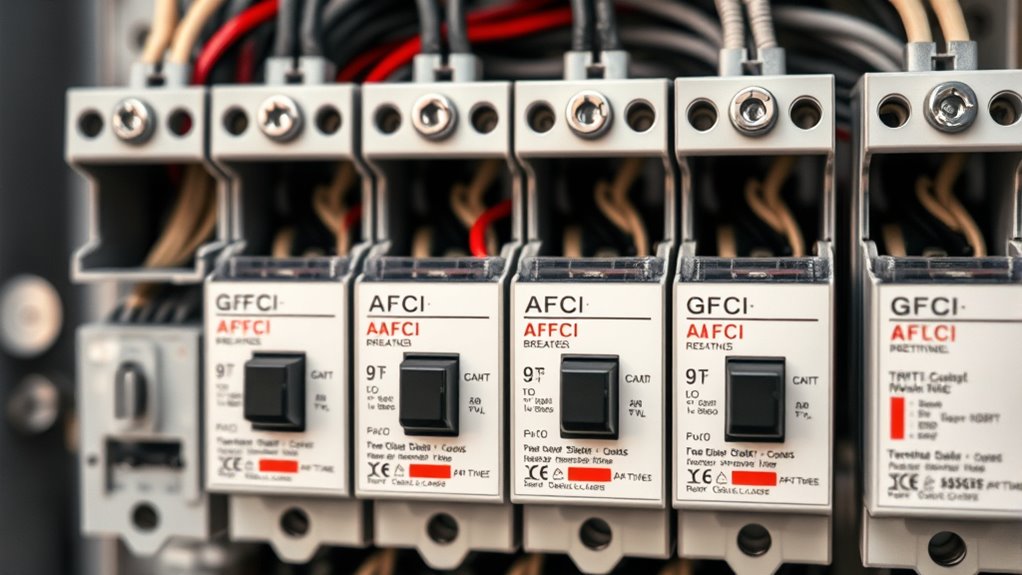
To guarantee safe and reliable operation when using AFCIs and GFCIs together, you should follow specific best practices. First, ensure proper coordination between devices to prevent nuisance tripping. Second, verify that AFCIs can detect potential arc faults without interfering with GFCI ground fault detection. Third, install AFCIs on circuits prone to arc detection, especially in areas with high electrical activity. Fourth, regularly test both devices to confirm proper functioning and responsiveness to ground faults and arc faults. Using these best practices helps reduce the risk of ground fault issues while maintaining effective arc detection. Proper installation and maintenance ensure the devices operate harmoniously, providing safety from both ground faults and arc-related electrical hazards. Additionally, understanding the transformative power of decluttering can help maintain a tidy electrical panel, making it easier to access and test these safety devices effectively.
Mistakes to Avoid When Dealing With Circuit Interrupters
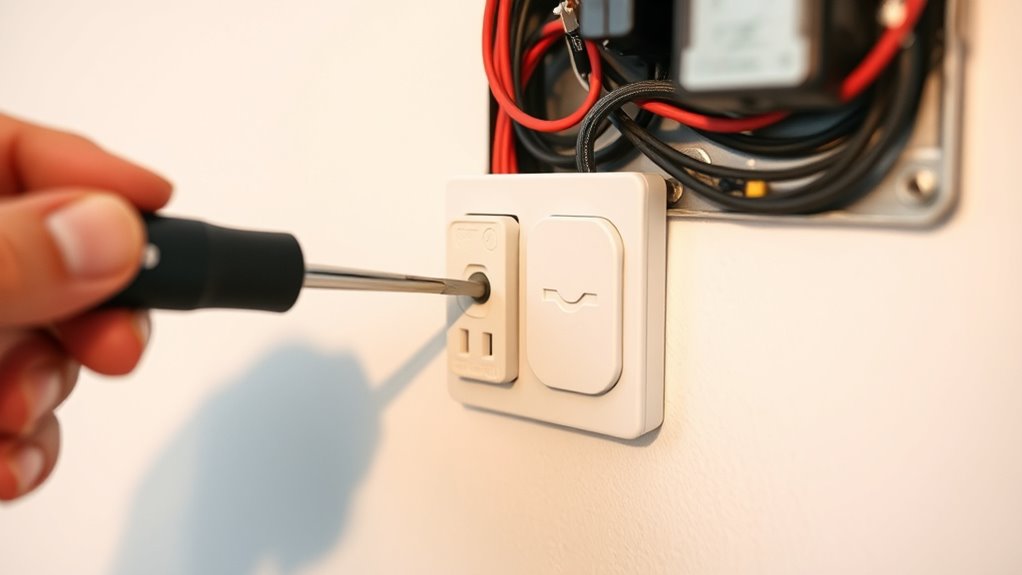
When working with circuit interrupters like AFCIs and GFCIs, mistakes can compromise safety and cause unnecessary disruptions. One common error is believing circuit breaker myths that suggest these devices are unnecessary or overly sensitive. Such wiring safety misconceptions can lead you to bypass or disable these safety features, increasing the risk of electrical fires or shocks. Another mistake is improper installation—using incorrect wiring methods or ignoring manufacturer instructions. Always verify you understand how these devices function and follow proper procedures. Avoid replacing a GFCI or AFCI with a standard breaker without proper analysis. Misusing or neglecting regular testing can also reduce effectiveness. Additionally, understanding the contrast ratio and other performance features of circuit interrupters can help you select the most appropriate device for your specific needs. Stay informed, follow safety guidelines, and don’t underestimate the importance of correct installation and maintenance.
Frequently Asked Questions
Can AFCIS and GFCIS Be Installed on the Same Circuit Safely?
Yes, you can safely install AFCIs and GFCIs on the same circuit if you follow proper device installation and guarantee circuit compatibility. This setup provides enhanced protection against arc faults and ground faults. Make sure to install each device according to the manufacturer’s instructions and local electrical codes. Consulting a licensed electrician is recommended to verify compatibility and ensure safe, code-compliant installation.
Do AFCIS Prevent Electrical Fires Caused by Arc Faults?
Yes, AFCIs help prevent electrical fires caused by arc faults. They detect unintended arcing that can generate heat and ignite fires, and then trip the circuit to stop the danger. Installing AFCIs is a smart fire prevention measure, especially in bedrooms and living areas where arc faults are more common. By doing so, you considerably reduce the risk of electrical fires and protect your home and loved ones.
Are GFCIS Effective in Outdoor or Wet Locations?
You bet GFCIs are effective in outdoor or wet locations, but don’t forget the weather resistance factor. They’re designed to prevent shocks in damp environments, but you must follow installation guidelines carefully. Properly installed GFCIs provide an essential safety net, protecting you from electrical hazards. Just remember, neglecting weatherproofing or installation procedures can turn their effectiveness into a false sense of security, so always use GFCIs suited for outdoor use.
How Often Should GFCIS and AFCIS Be Tested for Safety?
You should test your GFCIs and AFCIs monthly to guarantee safety. Electrical code updates recommend regular testing, and installation guidelines emphasize this routine. To do so, simply press the test button on each device and confirm the reset button works properly. This simple step helps prevent electrical hazards. Remember, staying consistent with testing keeps your home safe and compliant with current safety standards.
What Are the Signs of a Malfunctioning AFCI or GFCI Device?
If your AFCI or GFCI device isn’t functioning properly, you’ll notice it trips frequently without reason, or fails to trip when there’s a problem. During circuit troubleshooting, you might see physical signs like burn marks, or smell burnt odors around the device. Regular device inspection helps catch issues early, ensuring safety and proper operation. If anything seems off, replace or repair the device promptly to prevent hazards.
Conclusion
Understanding the differences and proper use of AFCIs and GFCIs can critically enhance your home’s safety. Did you know that installing both devices together reduces electrical fires by up to 80%? By following best practices and avoiding common mistakes, you protect your loved ones and your property. Remember, using these devices correctly isn’t just a myth-busting exercise — it’s an essential step toward safer, more reliable electrical systems in your home.
